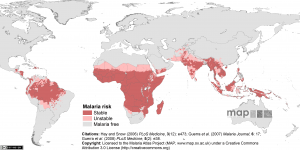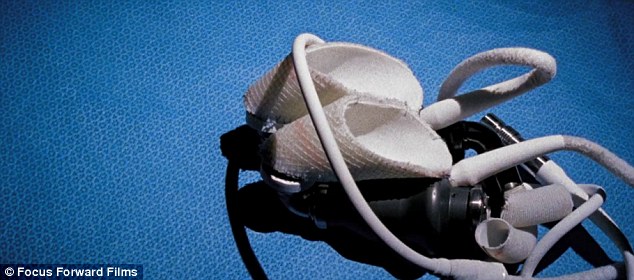Each year, more than a million people die of the harmful parasitic disease known as Malaria and this number is increasing each day. Approximately 3.3 billion people (this is almost half the population of the world!) live in Malaria-affected region; most prominently in the Sub-Saharan Africa. This harmful plague has been circulating our planet for a long time now and yet there is no known cure for this disease. In the past recent years, the parasite has developed resistance to a lot of drugs. According to some researchers, some prosperous nations were able to get rid of Malaria; it is the third-world countries where the number of deaths due to this disease keeps increasing. Figure 1. below shows the regions that are at risk of Malaria. Fortunately, Malaria is no longer overlooked and there is extensive research being done to find the cure for this malicious disease.
 Figure 1. World map showing the risk of Malaria across the world.
Figure 1. World map showing the risk of Malaria across the world.

From the genus Anopheles, the female mosquito attacks the human when it is sound asleep and drinks the blood without acknowledgement. In the process, she releases saliva to prevent blood coagulation, and it is at this point when the infection spreads in the human body. This saliva contains one-celled malaria parasites (plasmodia) that act like tiny microscopic worms and burrow themselves in different liver cells. From this point on the disease spreads in the body through red blood cells and causes symptoms such as fever, headache, chills, nausea etc. The following video shows what happens in detail once the parasite attacks the host:
Researchers and doctors from all around the world are working hard to develop, not just vaccines, but drugs that might help cure Malaria. Through the use of chemical insecticides or drainage of the water where the larvae of these mosquitos live in, could result in a significant reduction of their population.
Additionally, several drugs are under work that may be effective on a small scale. One such company is GlaxoSmithKline that developed a vaccine and conducted a clinical trial on 15,000 babies and children in Africa. Up to 18 months of age, the drug worked effectively and protected the babies. But the effectiveness wore off afterwards. A Research team at the University of Cape Town have been working on a drug that worked adequately on animals with no adverse side effects. Once this drug is put to use in clinical trials and positive results are found, it might be the breakthrough to the cure for this disease.
Even though there isn’t a set cure for this disease yet, there is still some ongoing progress. Until further research is done and results are found, we can only hope that this plague is cured before it gets too late.
– Hiba Rajpar
References
http://www.globalpost.com/dispatch/news/regions/africa/131008/cure-malaria-new-vaccine-could-save-millions
http://science.nationalgeographic.com/science/health-and-human-body/human-diseases/raging-malaria/
http://newswatch.nationalgeographic.com/2012/08/29/university-of-cape-town-researchers-believe-they-have-found-a-single-dose-cure-for-malaria/





